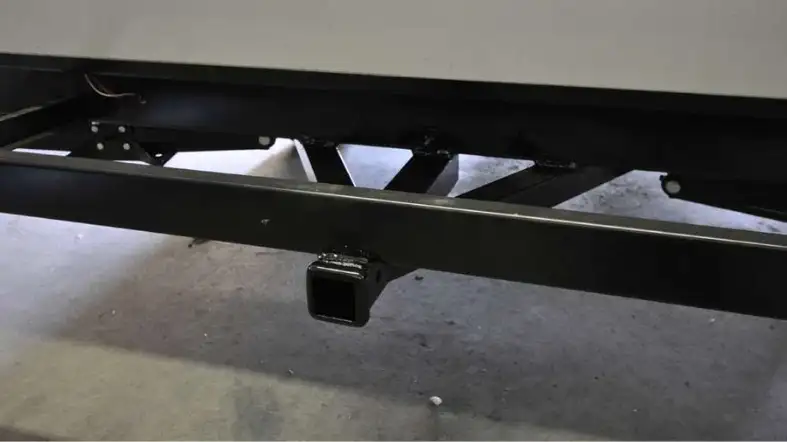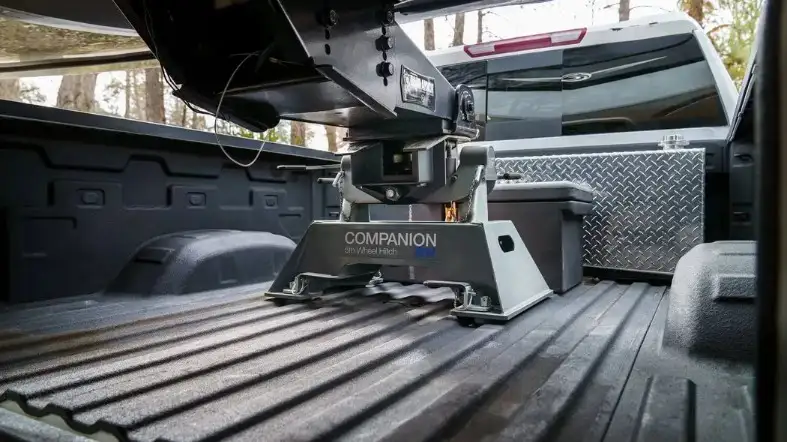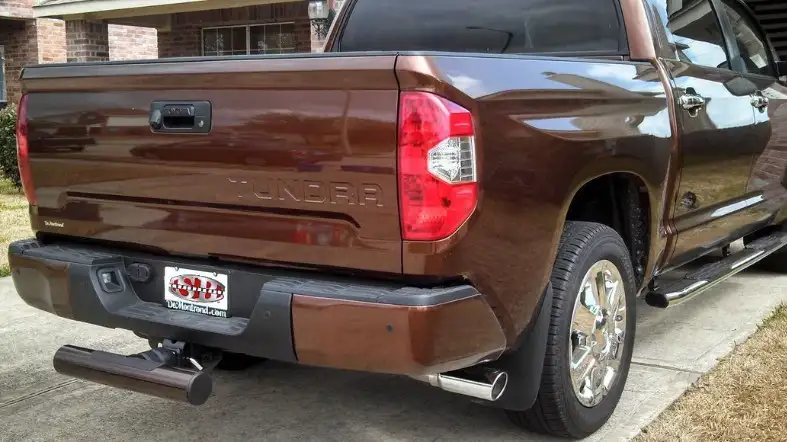It might be difficult to understand trailer hitches if you’ve never worked with one before.
But, if you want to employ one for hauling necessities, you have to gather some knowledge about the trailer hitches.
That’s why this article is aimed at simplifying your learning process.
Apart from a Trailer Hitch Compatibility Chart, we will explain the various type of trailer hitches available with an all-inclusive guide for you.

So, it will help you choose the trailer hitch most suited for your needs.
Here we go then!
Compatibility chart based on vehicle models:
When choosing a trailer hitch, the first thing you have to decide is the class/type of the hitch. Not every hitch will fit your vehicle or needs.
So, this Trailer Hitch Compatibility Chart simply represents the compatibility of the different classes of receiver hitches for the many types of vehicles out there.
| Vehicle Type | Hitch Class | Bike Racks | Cargo Loads and Baskets | Scooter and Motorcycle Racks | Small Trailers (Up to 2000 pounds) | Large Trailers (Up to 3,500 pounds) | Big Trailers (3,500-12,000 pounds) | Heavy-Duty Trailers (12,000-16,000 pounds) |
|---|---|---|---|---|---|---|---|---|
| Compact and Subcompact | Class I | 2 Bike Racks | N/A | N/A | ✓ | N/A | N/A | N/A |
| Full-Size Sedans | Class I and II | 2-3 Bike Racks | Not Recommended | Not Recommended | Class I | Class II | N/A | N/A |
| Crossover | Class I, II, and III | 2-5 Bike Racks | Class III | Class II, III | Class I | Class II | Class II | N/A |
| Minivans | Class II, III | 2-5 Bike Racks | Light to Heavy-Duty Cargo | Class III | Class II | Class II | Class III | N/A |
| SUVs | Class II, III | 2-5 Bike Racks | Light to Heavy-Duty Cargo | Class III | Class II | Class II | Class III | N/A |
| 1-2 Tons Trucks and SUVs | Class III, IV, V | 2-5 Bike Racks | Heavy-Duty Cargo | Fully Compatible | Class III | Class IV | Class V | Class V |
| 3-4 Tons Trucks | Class III, IV, V | 2-5 Bike Racks | Heavy-Duty Cargo | Fully Compatible | Class III | Class IV | Class V | Class V |
Types of trailer hitches and compatibility guide:
If you explore the trailer hitch world, you will find at least 7 types of trailer hitches.
So, you have to be very careful while picking one for your needs.
The compatibility chart above clarifies what hitch class suits you, yet leaves a lot of voids as to which hitch type you have to go for.
So, we will know about the types of trailer hitches.
| Hitch Type | Capacity | Function | Availability |
|---|---|---|---|
| Rear Receiver Hitch | Up to 20,000 pounds | Operates via a tube for the accessories | Useable with almost all the vehicles |
| Front Mount Hitch | Up to 20,000 pounds | Operates via a tube for the accessories | Useable with almost all the vehicles |
| 5th Wheel Hitch | Up to 30,000 pounds | Links up with a 5th wheel kingpin | Usable with pickup trucks only |
| Gooseneck Hitch | Up to 38,000 pounds | Links up with a gooseneck trailer | Usable with pickup trucks only |
| Pintle Hitch | Up to 60,000 pounds | Links up with lunette ring | Usable with heavy-duty vehicles |
| Bumper Hitch | 3,000-5,000 pounds | Links to the vehicle bumper | Usable with compact vehicles |
| Weight Distribution Hitch | Up to 15,000 pounds | Levels the vehicle and trailer | Usable with receiver hitches only |
Rear Receiver Hitch:

This is the hitch that we use randomly for almost any and every need.
So, their versatility is beyond the reach of any other type of trailer hitches.
A rear receiver hitch attaches to the back of your car, as the name tells you.
This sort of hitch is the best option if you want to pull a standard trailer on a regular basis.
There’s a square tube on the hitch.
This square tube serves as a hitch receiver, allowing you to attach various attachments, such as a ball hitch, of your preference.
In other words, the rear receiver hitch may be used to haul a wide range of trailers and attachments.
We’ll get into the many options for rear receiver hitch sizes in a moment.
Then you will get to know their compatibility and all.
Front Mount Hitch:
A front-mounted hitch is an alternative to a hitch mounted at the back of a vehicle.
Consequently, the final product will be an attachment to the front end of the automobile.
A front mount hitch, as you may guess, is limited in its usefulness.
It will be practically unusable for towing trailers. It’s very much impossible to tow something that’s in front of you.
This type of hitch is commonly employed by those who wish to tow snow plows and other similar devices.
However, there is additional tire storage space is available in this hitch.
Also, it is ideal for mounting a winch.
So, it could be worthwhile to have such a hitch if you engage in a great deal of off-roading.
Speaking in general, both a front- and a rear-mounted hitch installation are simple tasks.
But, when using them at the same time, you must be careful not to exceed the towing capacity of your vehicle.
5th Wheel Hitch:

A regular rear mount hitch might not be strong enough to support the weight of your RV or trailer.
Moreover, it’s not easy to attach a recreational vehicle to a regular tow hitch.
A 5th Wheel Hitch is exactly what you’ll require here.
The back of a pickup is the installation place for a 5th Wheel Hitch.
Therefore, a 5th-wheel hitch cannot be installed unless you own a truck.
These hitches have a high load capacity – 24,000 to 30,000 lbs.
This, however, will vary depending on the 5th Wheel Hitch you purchase, so be mindful to read the product description carefully.
The trailer will feature a so-called “King Pin.”
As part of the 5th Wheel Hitch assembly, it will fit into the trailer slot.
You may then secure the trailer in position using the 5th Wheel Hitch’s jaws.
Gooseneck Hitch:
Gooseneck hitches share some similarities with 5th-wheel hitches. 38,000-pound weight limit applies to this structure and it sits on the back of the automobiles.
A gooseneck hitch is similar to a ball hitch but in a vertical orientation.
They are far less heavy and occupy much less vertical space, so you can haul more items in the bed of a truck.
That’s why this type of hitch has greater use in the agriculture industry.
The majority of agricultural vehicles are built to employ this specific style of hitch.
These include cattle transporters, trailers for farming, etc.
Pintle Hitch:
Simply put, a pintle hitch is a large hook.
A pintle hitch requires an eyelet on the trailer you’re hitching up.
It’s not a common practice to employ a pintle hitch.
However, their weight rating is far above average.
There are choices available that can transport up to 60,000 pounds.
Once the pintle hitch hook is slipped inside the eyelet, the two will be attached.
This will secure it so that the vehicle can be towed.
The use of a pintle hitch is unusual in modern times.
However, if you already have a receiver hitch, you can probably find a conversion kit that will allow you to utilize it as a pintle hitch.
Bumper Hitch:

Bumper hitches should only be used for pulling a very light trailer.
For example, in no circumstances, should a bumper hitch be used to tow a horse trailer or recreational vehicle.
However, you may use this square hitch to connect a wide variety of trailer attachments.
It attaches to the vehicle’s bumper.
That’s why it has a limited capacity for carrying weight.
Weight Distribution hitch:
To begin with, the term “weight distribution hitch” does not refer to a distinct category of hitches.
On the contrary, it is an add-on that connects to a hitch receiver.
As its name implies, a weight-distribution hitch is used to do just that: evenly distribute weight.
This will alleviate some pressure on the hitch’s tongue. You’ll now be able to tow more weight than before.
Even though you don’t tow regularly, you might notice an improvement in handling.
You won’t get the impression that you’re dragging something massive down the highway.
Hitch class and compatibility:
| Type/class of hitch | Gross towing weight | Towing weight | Receiver opening | Compatible with |
|---|---|---|---|---|
| Class I | 1,000-2,000 Pounds | 100-200 pounds | 1-1/4 inches | Minivans, SUVs, Full-size cars, Compact cars, Midsize cars, Sedan |
| Class II | 2,000-3,500 pounds | 200-525 pounds | 1-1/4 inches | Minivans, SUVs, Full-size cars, Compact cars, Midsize cars, Sedan |
| Class III | 3,500-8,000 pounds | 300-800 pounds | 2 inches | Sedans, SUVs, Large SUVs, Heavy-duty trucks, Trucks, Minivans, |
| Class IV | 5,000-12,000 pounds | 500-1200 pounds | 2 inches | Heavy-duty trucks, Large SUVs |
| Class V (Extra-Duty) | 16,000-17,000 pounds | 1,500-2,000 pounds | 2 inches | Heavy-duty trucks, commercial trucks, large SUVs |
| Class V (Commercial Duty) | 18,000-20,000 pounds | 2,000-2,500 pounds | 2-1/2-inches | Heavy-duty dually and chassis cab trucks |
Class I:

As you can see the receiver size, is the smallest class of trailer hitches.
So, of course, it lacks the intensive towing capacity.
We see this class of hitches with cars mostly and that too of compact size.
They will only allow to haul very small loads spanning to 2000 pounds, with a tongue weight of a maximum of 200 pounds.
Class II:
As an upgrade to Class I, this class of hitch can do a few bulky tasks.
It will mostly attach to mini and compact trucks and sedans but has a maximum towing capacity of 3,500 pounds (TW is 525 pounds maximum).
Class III:
With an upgraded towing capacity and universal compatibility standard, this is the most used hitch class.
Their versatility allows them to attach to almost any sort of SUV and truck.
The massive tongue weight capacity, up to 800 pounds, makes it worthy for large SUVs and heavy-duty trucks.
Aside from the capability of towing the biggest recreational vehicles and campers, they will be adequate for most recreational uses.
The universal 2″ receiver makes these compatible with a wide range of add-ons.
Class IV:
This hitch class is for pickups and sport utility vehicles.
Thanks to its 2″ receiver make it versatile enough to handle most tasks.
It is especially suitable for hauling commercial cargo than a pleasure craft.
Class V:
There is either an extra Duty or Commercial Duty class V hitch available for you.
An extra-duty Class V hitch is primarily intended for amusement.
On the other hand, the other one, as you can guess, is intended for business.
FAQs about trailer hitch compatibility chart
Does Trailer Hitch Compatibility Increase With Weight Distribution Hitch?
It has nothing to do with the compatibility of the trailer hitches.
Rather, it attaches to the receiver hitch to level the vehicle and trailer for safety and smooth hauling.
Which Class Of Hitch Is Most Compatible For General Use?
Class III hitch is most compatible for almost all-purpose use.
What Determines The Receiver Hitch Size?
What you intend to tow or haul, as well as the capabilities of your vehicle will determine it.
Final Words:
The trailer hitch compatibility chart is fairly enough to guide you through any hauling needs.
You just need to consider the total towing weight and capacity to align with the type of your vehicle.
However, always opt for a weight distribution for hitches of class III to V. Safety comes first!
